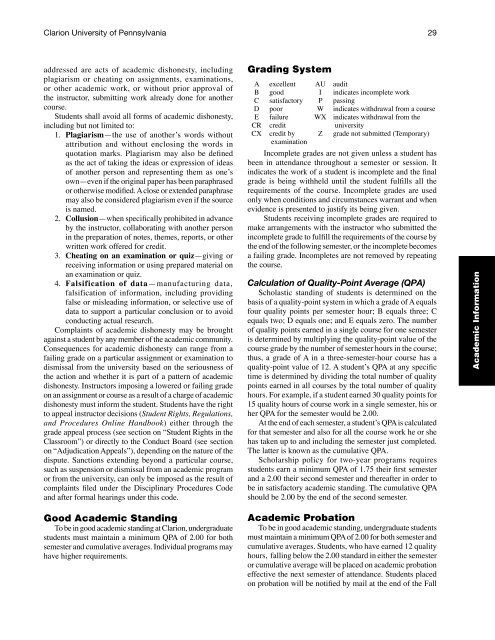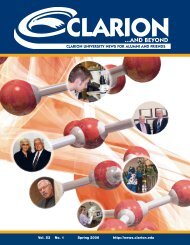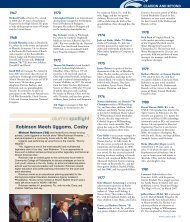Undergraduate - Clarion University
Undergraduate - Clarion University
Undergraduate - Clarion University
- No tags were found...
You also want an ePaper? Increase the reach of your titles
YUMPU automatically turns print PDFs into web optimized ePapers that Google loves.
<strong>Clarion</strong> <strong>University</strong> of Pennsylvania 29addressed are acts of academic dishonesty, includingplagiarism or cheating on assignments, examinations,or other academic work, or without prior approval ofthe instructor, submitting work already done for anothercourse.Students shall avoid all forms of academic dishonesty,including but not limited to:1. Plagiarism—the use of another’s words withoutattribution and without enclosing the words inquotation marks. Plagiarism may also be definedas the act of taking the ideas or expression of ideasof another person and representing them as one’sown—even if the original paper has been paraphrasedor otherwise modified. A close or extended paraphrasemay also be considered plagiarism even if the sourceis named.2. Collusion—when specifically prohibited in advanceby the instructor, collaborating with another personin the preparation of notes, themes, reports, or otherwritten work offered for credit.3. Cheating on an examination or quiz—giving orreceiving information or using prepared material onan examination or quiz.4. Falsification of data—manufacturing data,falsification of information, including providingfalse or misleading information, or selective use ofdata to support a particular conclusion or to avoidconducting actual research.Complaints of academic dishonesty may be broughtagainst a student by any member of the academic community.Consequences for academic dishonesty can range from afailing grade on a particular assignment or examination todismissal from the university based on the seriousness ofthe action and whether it is part of a pattern of academicdishonesty. Instructors imposing a lowered or failing gradeon an assignment or course as a result of a charge of academicdishonesty must inform the student. Students have the rightto appeal instructor decisions (Student Rights, Regulations,and Procedures Online Handbook) either through thegrade appeal process (see section on “Student Rights in theClassroom”) or directly to the Conduct Board (see sectionon “Adjudication Appeals”), depending on the nature of thedispute. Sanctions extending beyond a particular course,such as suspension or dismissal from an academic programor from the university, can only be imposed as the result ofcomplaints filed under the Disciplinary Procedures Codeand after formal hearings under this code.Grading SystemA excellent AU auditB good I indicates incomplete workC satisfactory P passingD poor W indicates withdrawal from a courseE failure WX indicates withdrawal from theCR credit universityCX credit by Z grade not submitted (Temporary)examinationIncomplete grades are not given unless a student hasbeen in attendance throughout a semester or session. Itindicates the work of a student is incomplete and the finalgrade is being withheld until the student fulfills all therequirements of the course. Incomplete grades are usedonly when conditions and circumstances warrant and whenevidence is presented to justify its being given.Students receiving incomplete grades are required tomake arrangements with the instructor who submitted theincomplete grade to fulfill the requirements of the course bythe end of the following semester, or the incomplete becomesa failing grade. Incompletes are not removed by repeatingthe course.Calculation of Quality-Point Average (QPA)Scholastic standing of students is determined on thebasis of a quality-point system in which a grade of A equalsfour quality points per semester hour; B equals three; Cequals two; D equals one; and E equals zero. The numberof quality points earned in a single course for one semesteris determined by multiplying the quality-point value of thecourse grade by the number of semester hours in the course;thus, a grade of A in a three-semester-hour course has aquality-point value of 12. A student’s QPA at any specifictime is determined by dividing the total number of qualitypoints earned in all courses by the total number of qualityhours. For example, if a student earned 30 quality points for15 quality hours of course work in a single semester, his orher QPA for the semester would be 2.00.At the end of each semester, a student’s QPA is calculatedfor that semester and also for all the course work he or shehas taken up to and including the semester just completed.The latter is known as the cumulative QPA.Scholarship policy for two-year programs requiresstudents earn a minimum QPA of 1.75 their first semesterand a 2.00 their second semester and thereafter in order tobe in satisfactory academic standing. The cumulative QPAshould be 2.00 by the end of the second semester.pages i-viiAcademic InformationGood Academic StandingTo be in good academic standing at <strong>Clarion</strong>, undergraduatestudents must maintain a minimum QPA of 2.00 for bothsemester and cumulative averages. Individual programs mayhave higher requirements.Academic ProbationTo be in good academic standing, undergraduate studentsmust maintain a minimum QPA of 2.00 for both semester andcumulative averages. Students, who have earned 12 qualityhours, falling below the 2.00 standard in either the semesteror cumulative average will be placed on academic probationeffective the next semester of attendance. Students placedon probation will be notified by mail at the end of the Fall
















